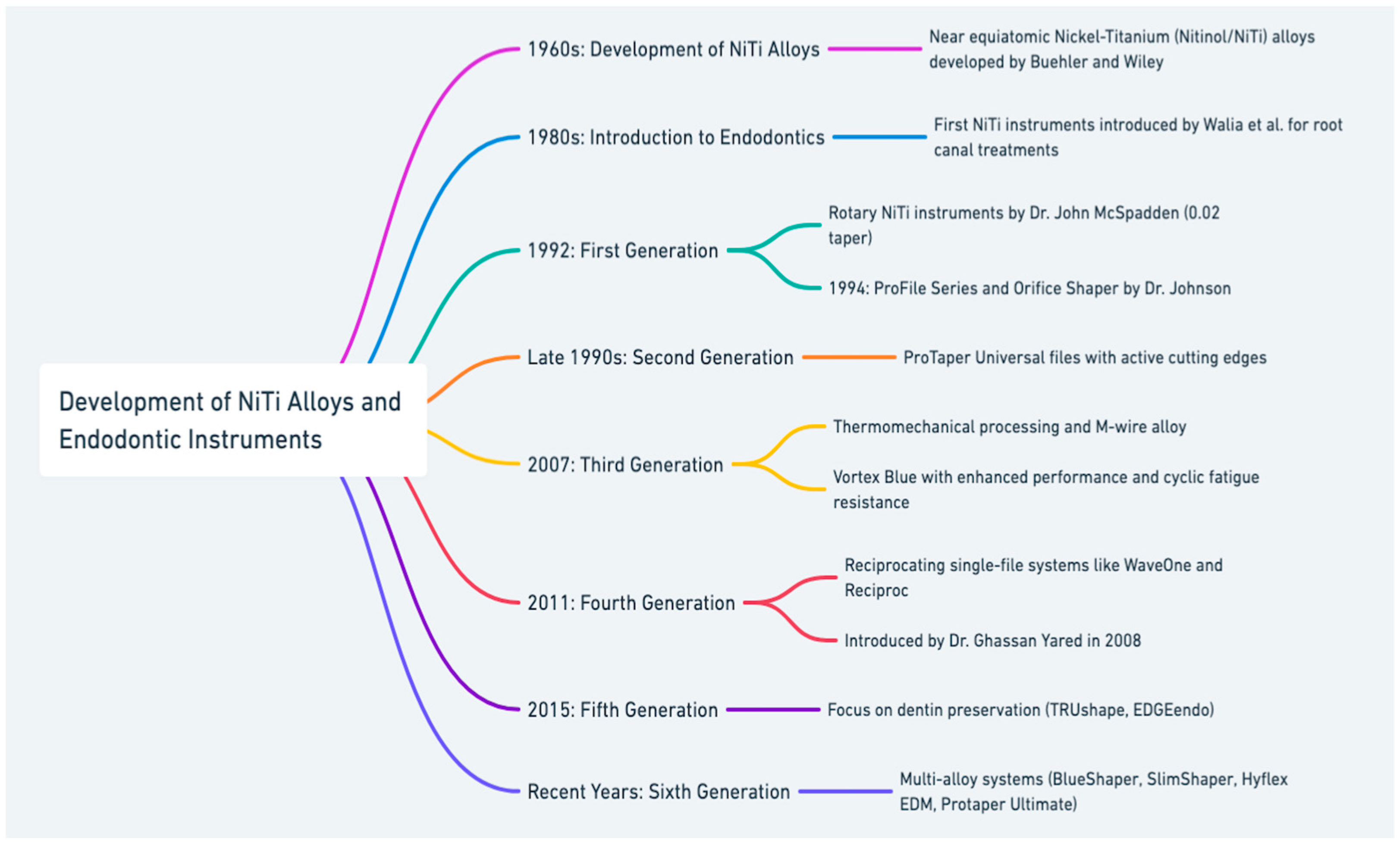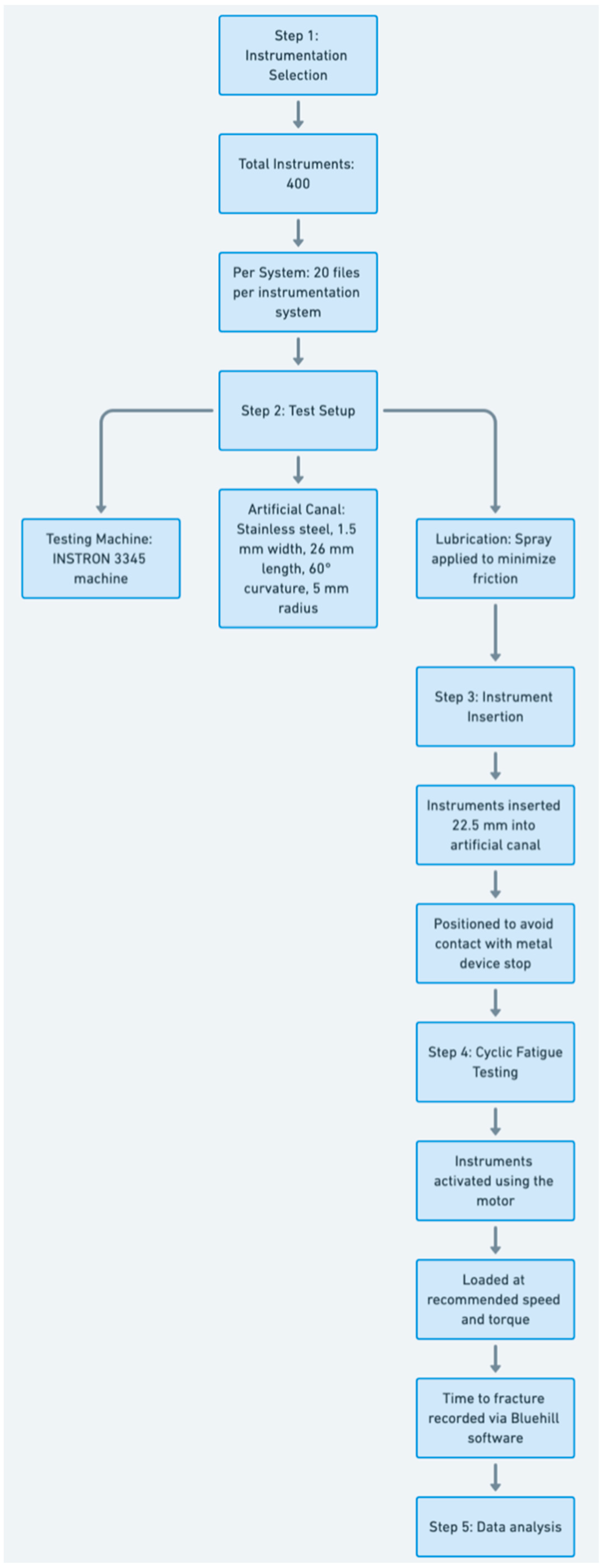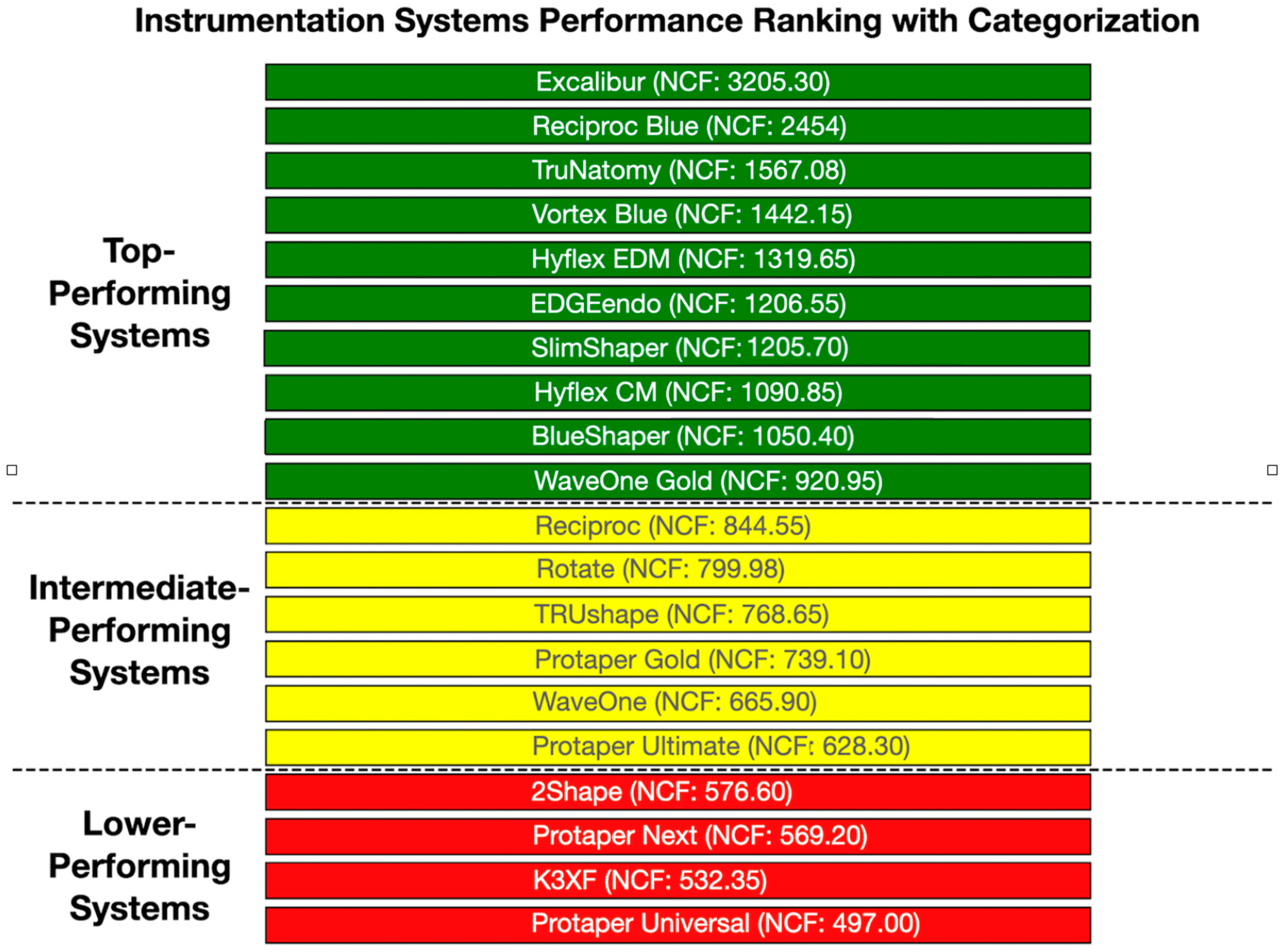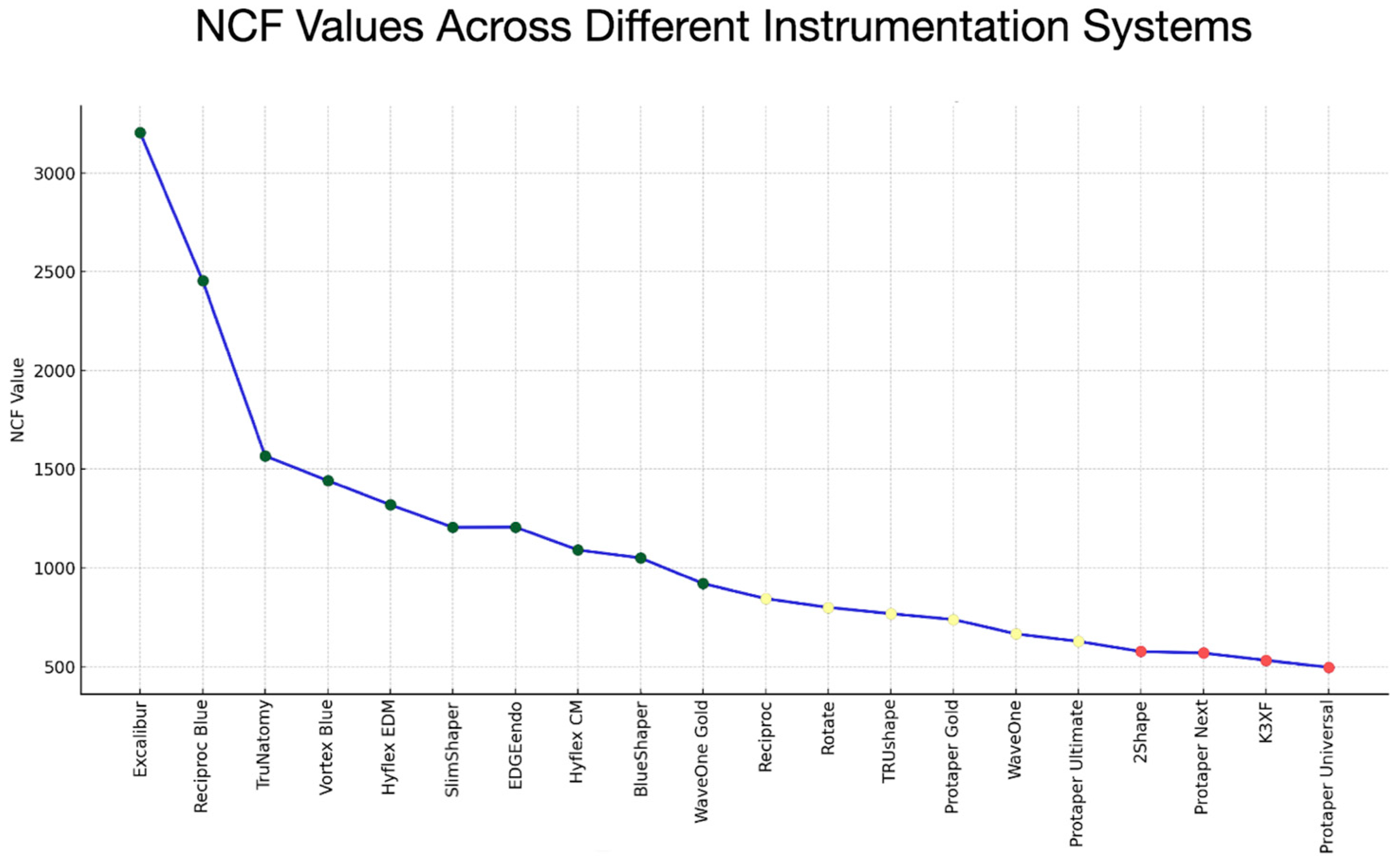Comparative Analysis of NiTi Instruments with Different Alloy Treatments
Abstract
1. Introduction
2. Materials and Methods
2.1. Endodontic Instrumentation Systems
2.2. Design of Files and Cyclic Fatigue
2.3. Statistical Analysis
3. Results
4. Discussion
5. Conclusions
Supplementary Materials
Author Contributions
Funding
Institutional Review Board Statement
Informed Consent Statement
Data Availability Statement
Conflicts of Interest
References
- Walia, H.M.; Brantley, W.A.; Gerstein, H. An initial investigation of the bending and torsional properties of Nitinol root canal files. J. Endod. 1988, 14, 346–351. [Google Scholar] [CrossRef] [PubMed]
- Namazikhah, M.S.; Mokhlis, H.R.; Alasmakh, K. Comparison between a hand stainless-steel K file and a rotary NiTi 0.04 taper. J. Calif. Dent. Assoc. 2000, 28, 421–426. [Google Scholar] [CrossRef] [PubMed]
- Thompson, S.A. An overview of nickel-titanium alloys used in dentistry. Int. Endod. J. 2000, 33, 297–310. [Google Scholar] [CrossRef] [PubMed]
- Haapasalo, M.; Shen, Y. Evolution of nickel–titanium instruments: From past to future. Endod. Top. 2013, 29, 3–17. [Google Scholar] [CrossRef]
- Shen, Y.; Zhou, H.M.; Zheng, Y.F.; Peng, B.; Haapasalo, M. Current challenges and concepts of the thermomechanical treatment of nickel-titanium instruments. J. Endod. 2013, 39, 163–172. [Google Scholar] [CrossRef]
- Gao, Y.; Gutmann, J.L.; Wilkinson, K.; Maxwell, R.; Ammon, D. Evaluation of the impact of raw materials on the fatigue and mechanical properties of ProFile Vortex rotary instruments. J. Endod. 2012, 38, 398–401. [Google Scholar] [CrossRef]
- Nehme, W.; Naaman, A.; Diemer, F.; Leotta, M.L.; La Rosa, G.R.M.; Pedullà, E. Influence of different heat treatments and temperatures on the cyclic fatigue resistance of endodontic instruments with the same design. Clin. Oral Investig. 2023, 27, 1793–1798. [Google Scholar] [CrossRef]
- Bueno, C.S.P.; Oliveira, D.P.; Pelegrine, R.A.; Fontana, C.E.; Rocha, D.G.P.; Gutmann, J.L.; Bueno, C.E.S. Fracture incidence of WaveOne Gold files: A prospective clinical study. Int. Endod. J. 2020, 53, 1192–1198. [Google Scholar] [CrossRef]
- Yared, G. Canal preparation using only one Ni-Ti rotary instrument: Preliminary observations. Int. Endod. J. 2008, 41, 339–344. [Google Scholar] [CrossRef]
- Yoo, Y.S.; Cho, Y.B. A comparison of the shaping ability of reciprocating NiTi instruments in simulated curved canals. Restor. Dent. Endod. 2012, 37, 220–227. [Google Scholar] [CrossRef]
- Pedullà, E.; Kharouf, N.; Caruso, S.; La Rosa, G.R.M.; Jmal, H.; Haikel, Y.; Mancino, D. Torsional, Static, and Dynamic Cyclic Fatigue Resistance of Reciprocating and Continuous Rotating Nickel-Titanium Instruments. J. Endod. 2022, 48, 1421–1427. [Google Scholar] [CrossRef]
- Thu, M.; Ebihara, A.; Maki, K.; Miki, N.; Okiji, T. Cyclic Fatigue Resistance of Rotary and Reciprocating Nickel-Titanium Instruments Subjected to Static and Dynamic Tests. J. Endod. 2020, 46, 1752–1757. [Google Scholar] [CrossRef] [PubMed]
- Clark, D.; Khademi, J.A. Case studies in modern molar endodontic access and directed dentin conservation. Dent. Clin. N. Am. 2010, 54, 275–289. [Google Scholar] [CrossRef] [PubMed]
- Krishan, R.; Paqué, F.; Ossareh, A.; Kishen, A.; Dao, T.; Friedman, S. Impacts of conservative endodontic cavity on root canal instrumentation efficacy and resistance to fracture assessed in incisors, premolars, and molars. J. Endod. 2014, 40, 1160–1166. [Google Scholar] [CrossRef]
- Aazzouzi-Raiss, K.; Ramírez-Muñoz, A.; Mendez, S.P.; Vieira, G.C.S.; Aranguren, J.; Pérez, A.R. Effects of Conservative Access and Apical Enlargement on Shaping and Dentin Preservation with Traditional and Modern Instruments: A Micro-computed Tomographic Study. J. Endod. 2023, 49, 430–437. [Google Scholar] [CrossRef]
- Martins, J.N.R.; Silva, E.; Marques, D.; Ajuz, N.; Rito Pereira, M.; Pereira da Costa, R.; Braz Fernandes, F.M.; Versiani, M.A. Characterization of the file-specific heat-treated ProTaper Ultimate rotary system. Int. Endod. J. 2023, 56, 530–542. [Google Scholar] [CrossRef]
- Yao, J.H.; Schwartz, S.A.; Beeson, T.J. Cyclic fatigue of three types of rotary nickel-titanium files in a dynamic model. J. Endod. 2006, 32, 55–57. [Google Scholar] [CrossRef]
- Plotino, G.; Grande, N.M.; Testarelli, L.; Gambarini, G. Cyclic fatigue of Reciproc and WaveOne reciprocating instruments. Int. Endod. J. 2012, 45, 614–618. [Google Scholar] [CrossRef] [PubMed]
- Siqueira, J.F., Jr.; Pérez, A.R.; Marceliano-Alves, M.F.; Provenzano, J.C.; Silva, S.G.; Pires, F.R.; Vieira, G.C.S.; Rôças, I.N.; Alves, F.R.F. What happens to unprepared root canal walls: A correlative analysis using micro-computed tomography and histology/scanning electron microscopy. Int. Endod. J. 2018, 51, 501–508. [Google Scholar] [CrossRef]
- Hülsmann, M.; Donnermeyer, D.; Schäfer, E. A critical appraisal of studies on cyclic fatigue resistance of engine-driven endodontic instruments. Int. Endod. J. 2019, 52, 1427–1445. [Google Scholar] [CrossRef]
- Al-Obaida, M.I.; Merdad, K.; Alanazi, M.S.; Altwaijry, H.; AlFaraj, M.; Alkhamis, A.A.; Al-Madi, E.M. Comparison of Cyclic Fatigue Resistance of 5 Heat-treated Nickel-titanium Reciprocating Systems in Canals with Single and Double Curvatures. J. Endod. 2019, 45, 1237–1241. [Google Scholar] [CrossRef] [PubMed]
- Adıgüzel, M.; Capar, I.D. Comparison of Cyclic Fatigue Resistance of WaveOne and WaveOne Gold Small, Primary, and Large Instruments. J. Endod. 2017, 43, 623–627. [Google Scholar] [CrossRef] [PubMed]
- Plotino, G.; Grande, N.M.; Mercadé Bellido, M.; Testarelli, L.; Gambarini, G. Influence of Temperature on Cyclic Fatigue Resistance of ProTaper Gold and ProTaper Universal Rotary Files. J. Endod. 2017, 43, 200–202. [Google Scholar] [CrossRef] [PubMed]
- Pirani, C.; Iacono, F.; Generali, L.; Sassatelli, P.; Nucci, C.; Lusvarghi, L.; Gandolfi, M.G.; Prati, C. HyFlex EDM: Superficial features, metallurgical analysis and fatigue resistance of innovative electro discharge machined NiTi rotary instruments. Int. Endod. J. 2016, 49, 483–493. [Google Scholar] [CrossRef] [PubMed]
- Riyahi, A.M.; Bashiri, A.; Alshahrani, K.; Alshahrani, S.; Alamri, H.M.; Al-Sudani, D. Cyclic Fatigue Comparison of TruNatomy, Twisted File, and ProTaper Next Rotary Systems. Int. J. Dent. 2020, 2020, 3190938. [Google Scholar] [CrossRef]
- Arias, A.; Hejlawy, S.; Murphy, S.; de la Macorra, J.C.; Govindjee, S.; Peters, O.A. Variable impact by ambient temperature on fatigue resistance of heat-treated nickel titanium instruments. Clin. Oral Investig. 2019, 23, 1101–1108. [Google Scholar] [CrossRef]
- Dosanjh, A.; Paurazas, S.; Askar, M. The Effect of Temperature on Cyclic Fatigue of Nickel-titanium Rotary Endodontic Instruments. J. Endod. 2017, 43, 823–826. [Google Scholar] [CrossRef]
- Keles, A.; Uzunoglu Ozyurek, E.; Uyanik, M.O.; Nagas, E. Effect of Temperature of Sodium Hypochlorite on Cyclic Fatigue Resistance of Heat-treated Reciprocating Files. J. Endod. 2019, 45, 205–208. [Google Scholar] [CrossRef]





| Protaper Universal | Protaper Next | 2Shape | K3XF | |
|---|---|---|---|---|
| NCF | 497.0 (497.0; 393–665) | 569.2 (575.0; 474–690) | 576.6 (575.0; 435–750) | 532.3 (525.0; 413–720) |
| Time | 97.8 (99.5; 79–133) | 113.9 (115.0; 95–138) | 115.4 (115.0; 87–150) | 106.46 (105.0; 83–118) |
| BlueShaper | SlimShaper | Protaper Gold | Protaper Ultimate | Hyflex EDM | Hyflex CM | TRUshape | EDGE Endo | Vortex Blue | Trunatomy | Rotate | |
|---|---|---|---|---|---|---|---|---|---|---|---|
| NCF | 1050.4 (1062.5; 792–1400) | 1205.7 (1206.5; 999–1396) | 739.1 (762.5; 470–1020) | 628.3 (613.0; 540–780) | 1319.6 (1354.0; 858–2133) | 1090.8 (1037.5; 658–1642) | 768.6 (771.5; 502–1080) | 1206.5 (1240.0; 817–1767) | 1442.1 (1420.5; 1029–2000) | 1567 (1440.4;1125–2245) | 799.9 (775.7; 555–925) |
| Time | 144.7 (145.0; 120–167) | 126.0 (127.5; 95–168) | 147.9 (152.5; 94–204) | 94.2 (92.0; 81–117) | 158.5 (162.5; 103–256) | 131.0 (124.5; 79–197) | 155.1 (154.5; 116–216) | 180.5 (186.0; 123–265) | 173.1 (170.5; 124–240) | 188.1 (183.1; 113–285) | 199.98 (193.1; 111–295) |
| Reciproc Convén | Reciproc Blue | WaveOne Conven | WaveOne Gold | Excalibur | |
|---|---|---|---|---|---|
| NCF | 844.5 (837.5; 505–1075) | 2454.0 (2516.5; 1967–2673) | 665.9 (640.5; 531–913) | 920.9 (875.5; 735–1243) | 3205.3 (3096.5; 2493–4100) |
| Time | 168.9 (167.5; 101–215) | 368.1 (377.5; 295–401) | 114.2 (110.0; 91–157) | 157.9 (150.0; 126–213) | 480.8 (464.5; 374–615) |
Disclaimer/Publisher’s Note: The statements, opinions and data contained in all publications are solely those of the individual author(s) and contributor(s) and not of MDPI and/or the editor(s). MDPI and/or the editor(s) disclaim responsibility for any injury to people or property resulting from any ideas, methods, instructions or products referred to in the content. |
© 2024 by the authors. Licensee MDPI, Basel, Switzerland. This article is an open access article distributed under the terms and conditions of the Creative Commons Attribution (CC BY) license (https://creativecommons.org/licenses/by/4.0/).
Share and Cite
Aranguren, J.; Oliveros-Porras, F.; Ramírez-Muñoz, A.; Pérez, I.; Salamanca-Ramos, M.; Aazzouzi-Raiss, K.; Pérez, A.R. Comparative Analysis of NiTi Instruments with Different Alloy Treatments. Materials 2024, 17, 4817. https://doi.org/10.3390/ma17194817
Aranguren J, Oliveros-Porras F, Ramírez-Muñoz A, Pérez I, Salamanca-Ramos M, Aazzouzi-Raiss K, Pérez AR. Comparative Analysis of NiTi Instruments with Different Alloy Treatments. Materials. 2024; 17(19):4817. https://doi.org/10.3390/ma17194817
Chicago/Turabian StyleAranguren, José, Felipe Oliveros-Porras, Ana Ramírez-Muñoz, Irene Pérez, Marcela Salamanca-Ramos, Karim Aazzouzi-Raiss, and Alejandro R. Pérez. 2024. "Comparative Analysis of NiTi Instruments with Different Alloy Treatments" Materials 17, no. 19: 4817. https://doi.org/10.3390/ma17194817
APA StyleAranguren, J., Oliveros-Porras, F., Ramírez-Muñoz, A., Pérez, I., Salamanca-Ramos, M., Aazzouzi-Raiss, K., & Pérez, A. R. (2024). Comparative Analysis of NiTi Instruments with Different Alloy Treatments. Materials, 17(19), 4817. https://doi.org/10.3390/ma17194817







